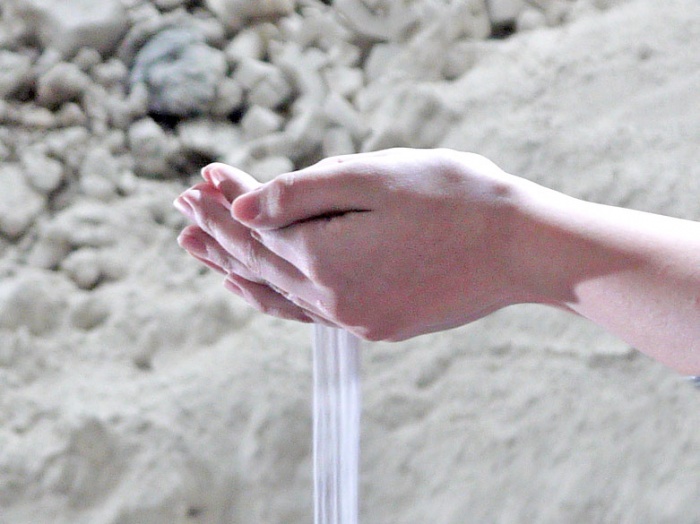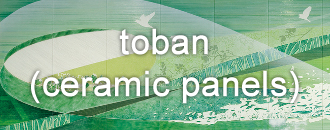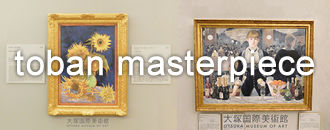― Introduction ―
Otsuka Ohmi Ceramics’ large ceramic boards were born in 1973 out of a desire to make a building material using sand from the Naruto Straits. This simple idea later blossomed into the use of ceramic boards for artwork and photographs, seen in the compilation of numerous examples of this “ceramic board masterpiece art” at the Otsuka Museum of Art, and it has further evolved into the diverse product line the company manufactures today.
The story of the birth of Otsuka Ohmi Ceramics large ceramic boards is described in the essay “A Handful of Sand”* written in 1998 by Masahito Otsuka, the first director of the Otsuka Museum of Art and the first president of Otsuka Ohmi Ceramics.
* “A Handful of Sand” was the first museum director’s contribution to the publication, The 100 Masterpieces Selected by The Otsuka Museum of Art.
A handful of sand…
The late Masahito Otsuka,
The first Director of “The Otsuka Museum of Art”
Ex-Member of the Board and Counselor of all the corporations of Otsuka Group
Thanks to cooperation of many firms and individuals, we have established The Otsuka Museum of Art.This museum has been built to commemorate the 75th anniversary of Otsuka Pharmaceutical Company.
Back to the time where I was five years old, I recall that my father Busabro, found of Otsuka Pharmaceutical Company carried me over his shoulders and we went to see the construction site of his factory. In comparison with that of his boss, the size of my father’s factory seemed to be relatively very small.
“Dad! Our factory seems to be very tiny. Isn’t it?“ I exclaimed.
“Well, well! It is small indeed, but I will make sure to make bigger than that of my boss,“ my father said. His words still ring in my ears… as I now realize 75 years have since elapsed.
The original plan for developing our ceramic art boards is 27 years old. I was then President of all the corporation of Otsuka Group. My youngest brother, Masatomi Otsuka (now, President of Earth Chemical Co., Ltd), who was then Technical Manager of Otsuka Chemical Co., a member corporation of the Otsuka Group of companies, came into my office accompanied by Mr. Hiromasa Itagaki (now member of the Board of Directors of Otsuka Ohmi Ceramics Co., Ltd.) and poured a handful of sand on my desk.
“President, we need your help“, Masatomi said.
“What is this sand about?“ I wondered.
“This is the sand of the Naruto straits“ he replied.
Our factory was facing Kiisuido (the Canal of Kii) and the white sand was spread all along the strait, the specific place where that sand actually came from.
“We are in fact contemplating to make tiles out of this sand. It is now being used as a concrete component.
Special boats carry this sand to Osaka and Kobe where it is sold as construction material on a “per ton“ price basis. It would be, I believe, in the interest of Tokushima Prefecture and interest of Otsuka if we could manage to manufacture tiles using this sand and sell them on the basis of a “unit“ price. This will create goods that have an added value. We therefore wish you to plead with the Governor of Tokushima and acquire his permission to use this extracted sand in the manufacturing of concrete tiles“; Masatomi said stressing on his idea.
After I personally brought the idea to the attention of Mr. Yasunobu Takeishi (then Governor of Tokushima) and managed to acquire his consent, both Masatomi and Mr. Itagaki threatened me that they would resign from their jobs if Otsuka obstructed their plan for manufacturing the tiles.
I sincerely admired their attitude.
Following this episode, we set up a kiln within Naruto Factory and the production of small tiles began. The size of the tiles was increased gradually until we finally succeeded in producing perfectly made square of 1m x 1m. Out of 20 tiles that were produced, 20 tiles were acceptable. We thus managed to reach a 100% rate of success in the production of such tiles.
As a matter of fact, if we acknowledge that the production of large items using clay is, by itself, a very difficult process, we will then come to realize that the production of a perfectly smooth ceramic board is indeed a more complicated process. During the said period, even in America, the production on 20 such boards revealed that all but one (i.e., 19 of them) would be deemed to be of an unacceptable quality. Our technology in this field was comparatively advanced, I can say. This was a fascinating achievement and we were looking forward to acquiring an even higher degree of perfection in this production technology. A Joint venture was then set up between Otsuka and a corporation located in the town of Shigaraki, Shiga Prefecture; Ohmi Chemical Corporation. Its president was Mr. Takashi Okuda and its Plant Manager was Mr. Minoru Okuda (the actual President of Otsuka Ohmi Ceramics Co., Ltd,). I was nominated to be the President of the venture corporation: Otsuka Ohmi Ceramics Co., Ltd.
As you are certainly aware of, the year of 1973, when the new venture company was established, we witnessed the so-called “Oil Shock“. The price of crude oil increased twelve fold. All the building construction activities came to a complete halt and we had to face this exceptional situation. We were not in a position to run the company in accordance with the purpose for which it was established.
Following a deep reflection on the problem, the members of the Board of Directors came up with the following suggestion: to embellish the ceramic boards with pictures and therefore move forward with the product to the sector of Art. The first work of art was “Kakitsubata“ by Artist Ogata Korin. The image consisted of several ceramic boards of 1 meter (W) and 3 meters (H) each. They were to be fired in the kiln, produced without any defect on their surface and then had to be aligned next to each other. At that time, we had no major problems in the production of very large ceramic boards but we were definitely eager to produce top quality works of art.
Our research effort continued as we were putting more boards in the kiln, producing them and even, occasionally, destroying a part thereof.
The challenge that we had to face next was color. We managed to develop somewhere around 20,000 colors. This enabled us to produce copies, in the actual size, of those world famous pictures, including the paintings of Picasso and Miro. This achievement has evidently no parallel in our country and in the entire world and I proudly confirm that Otsuka has been successful in producing such large-sized ceramic boards.
When I went to Moscow in 1980 on a business trip in connection with an agreement on anti-malignant drugs for Taiho Pharmaceutical Co., I visited a cemetery in the outskirts of the Capital. On the top of Mr. Khrushchev’s tomb, I noticed his picture. I also noticed the pictures, the size of a name card, of those Soviet soldiers and nurses who perished during the great wars pasted on their tombs.
The picture of Mr. Khrushchev was probably as large as a Japanese standard magazine. It goes without saying that it was not made of tile. It was a paper photograph. Its surface was covered with a vinyl sheet to prevent it from the rain. The surface of the picture had, however, no prevention whatsoever from the effect of the ultra-violet rays of the sun. In spite of the fact that it seemed to be a relatively recent photograph, the portion of the face in the photo was discolored, its colors, in general, were fading and getting dull.
I then thought that if we could manage to have the photograph printed on ceramic boards, we will be able to produce a wonderful picture with preserved colors that will never fade.
In the past, the Dutch merchant ships used to carry the “Arita“ ceramics and other ceramics from China to Europe. The cargo load of one of those ships was seemingly hit by a cyclone in the way and therefore sunk in the Indian Ocean. Researchers managed to pull the shipwreck out from the ocean bed after hundreds of years. This operation revealed that the porcelain items found in the shipwreck had conserved their original shapes and colors. During that period of time, the ceramics used to be baked in the kilns at 1,000 degrees centigrade while, nowadays, we bake the clay of the art ceramic boards at 1,300 degrees centigrade using a special technology. We, therefore, expect the said ceramic boards to maintain their original appearance for a thousand or even two thousand years.
Let me now to speak about our ancestors. I have personally got to know my great grandfather, but no other ancestors further up in the line, whether males or females. I guess that the same goes for all of you. This is because those ancestor’s photographs do not exist. The same can be said about the ancestors of His Majesty the Emperor of Japan such as Emperor Jinmu, Amaterasu Ohmikami and others, Furthermore, at a later period, the same theory applies to celebrities like Takeda Shingen, Uesugi Kenshin, Oda Nobunaga, Toyotomi Hideyoshi, Tokugawa Ieyasu, Mouri Motonari etc… Their portraits do exist, though not their photographs. Should they have had their photos printed on Otsuka’s ceramic boards, their true physiognomy would have been likely preserved forever and the history of Japan would have certainly changed as well.
It is our obligation to convey Japan’s true face of today to the future generations. Moreover, because as a token of respect to their ancestors, off-springs have a duty to perform some rituals for their ancestors, over and above their obligation to take good care of their parents, we have developed impressive picture (portrait) ceramics both in colors and in black and white.
Our success in developing the ceramic art boards and the ceramic portrait boards was coincidental with the 50th anniversary of Otsuka Corporation. On that occasion, my late father’s suggestion was that “We should undertake and execute something that remains for the future generations, not limited to ourselves: something that we may share with all the population“. We were, regretfully, unable to fulfill his wish and he passed away at the age of 80.
Twenty-five years have elapsed since his death. At the end of World WarII, Otsuka had 17 employees. The total number of our employees now exceeds 23,000 out of which 7,000 employees are from Tokushima Prefecture. They all contributed to the growth of our enterprise. In a show of gratitude to the Prefecture of Tokushima for its long term cooperation, we decided to fulfill my father wish, a wish to which I personally fully agree as well, by building the commemorative monument of our 75th anniversary in Tokushima Prefecture. We have therefore established at this spot, located on the straits of Naruto, The Otsuka Museum of Art, a museum based on the concept that every visitor would be able to enjoy seeing the world’s most famous pictures of Western Art.
The construction work was smooth. The number of the exhibited images exceeded 1,000 pictures; all of them are now exhibited, and we were able to open the museum as per our original schedule. Under the leadership of Professor Masanori Aoyagi, the vice-Dean of Tokyo University, and taking into consideration our objective to offer a comprehensive Art education to a variety of students, we picked up the most famous images from ancient and contemporary Western Art and we arranged to have them exhibited in this museum.
We will certainly feel very happy if our visitors, having contemplated the images exhibited at our museum, may someday decide, on the occasion of their honeymoon, to travel overseas to see the original picture. They would then remember that they had already seen this or that image at our museum, when they were students, and that they then felt impressed by it.
Anyway, because these images are printed on ceramics, they will never fade, while the real original picture may, depending on its surrounding circumstances, possibly suffer some changes. I believe that the colors of the real original picture and those colors of its image on the ceramic boards will, when compared after 50 to 100 years from now, certainly show some differences. We founded this museum of famous Art works on ceramic boards because we are eager to convey the real look of the picture for an unlimited period of time, and in order to preserve it as an heritage for the future generations.
After your visit to this museum, please let us be aware of your comments on any irregularities that you may notice so that we may straighten them up. I believe that this museum is our contribution to the public for a 1000 or 2000 years to come. It is also our contribution to the people of Tokushima Prefecture.
In brief, a handful of sand has been the key in founding The Otsuka Museum of Art.
This is my message. I thank you very much for your support and cooperation.
March 1998
(Translated by: Fuado Otsuka)
==============================================
The Otsuka Museum of Art is an ideal venue for a large number of visitors to learn about Otsuka Ohmi Ceramics techniques for reproducing masterpieces on large ceramic boards. In recent years, we have achieved new successes and our reproductions are recognized as an important way of documenting, preserving, and keeping alive cultural assets, as exemplified by our reproduction of the Kitora burial mound frescos and other invaluable cultural assets.
Starting with “a handful of sand,” the manufacture of our ceramics has developed around three major categories: Large-Scale Ceramic Panels, terracotta, and OT ceramics. At Otsuka Ohmi Ceramics, we continue to dedicate ourselves to exploring all the possibilities of the world of ceramics.



